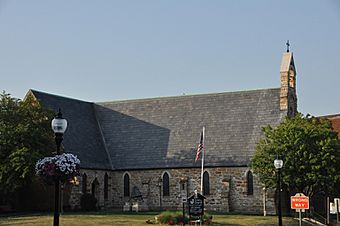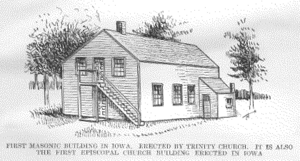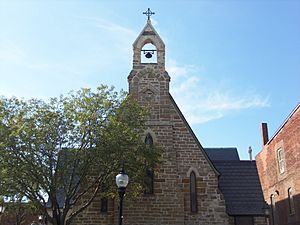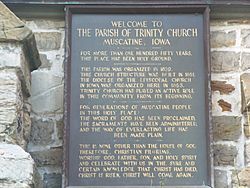Trinity Episcopal Church (Muscatine, Iowa) facts for kids
Quick facts for kids |
|
|
Trinity Episcopal Church
|
|
|
U.S. Historic district
Contributing property |
|
 |
|
| Location | 411 E. 2nd St. Muscatine, Iowa |
|---|---|
| Area | less than one acre |
| Built | 1851-1854 |
| Architect | Frank Will |
| Architectural style | Gothic Revival |
| Part of | Downtown Commercial Historic District (ID06000423) |
| NRHP reference No. | 74000803 |
| Added to NRHP | October 29, 1974 |
Trinity Episcopal Church is a special church located in Muscatine, Iowa, United States. It is part of the Episcopal Church in Iowa. This historic building was added to the National Register of Historic Places in 1974. This list helps protect important places in American history. In 2006, the church also became a key part of the Downtown Commercial Historic District in Muscatine.
Contents
A Look Back: Trinity Episcopal Church
How the Church Started in Muscatine
The story of the Episcopal Church in Muscatine began in 1839. That year, Matthew Matthews and his family arrived in the town, which was then called Bloomington. Soon after, a special church leader named Bishop Jackson Kemper visited them. He helped the community start their own church group. This was the very first Episcopal church group ever formed in Iowa!
The next year, Bishop Kemper visited again. He noted that the church had seven members and enough wood to build a church building. The bishop even gave $100 to help with the construction.
The first church building was made of wood. It was about 50 feet long and 22 feet wide. It had eight windows and a small room for the church leaders. When Trinity Church wasn't using the building, the Presbyterian Church held their services there. A bell was placed on the building, and both churches used it. Interestingly, a group called the Freemasons built a second floor on the building and used that part. Bishop Kemper did not like the Masons being there, so he refused to officially bless the church. Still, this was the first church of any kind built in Muscatine County. It was also the first Episcopal Church in all of Iowa.
At first, the church did not have its own full-time leader. A reverend named Zachariah Goldsmith from Trinity Church in Davenport would visit to lead services. On June 28, 1842, the church group was reorganized with fourteen people attending a meeting. Then, on May 12, 1843, a new leader, Reverend Samuel Sherwell, came from New York to take charge of the church.
Building the Current Church
In 1850, Reverend John B. Calhoun became the church leader. He asked the church members to donate money for a new church building. In the spring of 1851, sixteen members promised $1,250. Reverend Calhoun then traveled east to collect more donations. He gathered another $1,298.50 from 168 different people.
An architect named Frank Will from New York City was chosen to design the new church. The new building was constructed on the same spot as the old one. The basement and foundation were built in the fall of 1851. The first stone, called the cornerstone, was laid on November 11. It took three years to build the church. It is made of sandstone and designed in the Gothic Revival style. This style looks like old European cathedrals.
Bishop Kemper returned to Muscatine to officially bless the new church on May 25, 1854. He was helped by Reverend John Ufford. The building was made larger in 1855. At that time, it was given its cross-shaped design, known as a cruciform plan. A bell was placed in the bell tower in 1856. The beautiful oak furniture inside the church was added in 1887. This included the altar, pulpit, lectern, choir seats, and pews. The colorful stained glass windows in the side sections of the church were also added then. The large Ascension window at the end of the main hall was installed in 1896.
The Diocese of Iowa
The Diocese of Iowa is a larger organization that connects many Episcopal churches in the state. It was officially formed by Bishop Kemper in 1853. He invited church leaders and representatives from different churches in Iowa to a meeting at Trinity Church in Muscatine on August 17. Since the bishop was not there, Reverend Alfred Louderbeck from Trinity Church in Davenport was chosen to lead the meeting.
At this meeting, they created the rules and guidelines for the new diocese. They also made plans to choose a bishop for Iowa. On October 18, 1854, Reverend Henry Washington Lee was chosen as the first bishop of Iowa. He was the leader of St. Luke's Church in Rochester, New York at the time.
Since 1989, the Diocese of Iowa has been part of a program called Education in Ministry. This program helps people learn more about theology, which is the study of religious faith. Trinity Church in Muscatine and St. Paul's Indian Mission in Sioux City were the first places in Iowa where people could gather for this program.
Storm Damage
On August 9, 2010, lightning struck the church during a thunderstorm. This caused a lot of damage to the bell tower at the front of the church. An iron cross on top of the tower was also damaged.






